Addi Azmera
Addi Azmera is a tabia or municipality in the Dogu'a Tembien district of the Tigray Region of Ethiopia. The name refers to good spring rains (“azmera”), in relation to the local microclimate. The tabia centre is in Tukhul town, located approximately half-way between the woreda town Hagere Selam and the regional capital Mekelle.
Addi Azmera | |
|---|---|
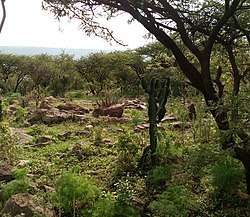 Vegetation regrowth (exclosure) in Sesemat | |
 Addi Azmera Location within Ethiopia | |
| Coordinates: 13°38′N 39°20′E | |
| Country | Ethiopia |
| Region | Tigray |
| Zone | Debub Misraqawi (Southeastern) |
| Woreda | Dogu'a Tembien |
| Area | |
| • Total | 106.67 km2 (41.19 sq mi) |
| Elevation | 1,950 m (6,400 ft) |
| Population (2007) | |
| • Total | 7,885 |
| • Density | 74/km2 (190/sq mi) |
| Time zone | UTC+3 (EAT) |
Geography
The tabia stretches on both sides of the main road that climbs towards Dogu’a Tembien after passing the bridge on Giba River. The highest location are the upper slopes of Imba Dogu’a (2590 m a.s.l.) and the lowest place along Giba River (1750 m a.s.l.). It comprises cultivated plains and steeper slopes, with often good vegetation (re)growth.
Geology
From the higher to the lower locations, the following geological formations are present:[1]
- Mekelle Dolerite[2]
- Amba Aradam Formation
- Agula Shale[3] - there are gypsum quarries in this formation, exploited by the cement factory of Mekelle
- Antalo Limestone – many quarries for building stones and gravel
- Quaternary alluvium and freshwater tufa[4]
Geomorphology and soils
The main geomorphic unit is the gently undulating Agula shale plateau with dolerite. Corresponding soil types are:[5]
- Dominant soil type: stony, dark cracking clays with good natural fertility (Vertic Cambisol)
- Associated soil types
- Inclusions
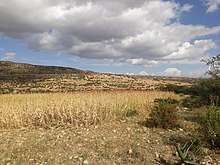
Rainfall in Addi Azmera
Due to its great difference in elevation, with slopes turned towards the wind direction (from east) during the short spring rains, orographic rains occur in that season.[6] This results in sufficient soil moisture for growing crops in that season. In such years with good spring rains (locally called “Azmera”) the whole plain, from Qarano to Afedena is sown with “azmera” crops, particularly sorghum. Hence the name “Addi Azmera”.
Springs
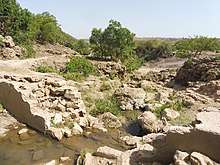

Besides Giba River at the eastern (lower) side of the tabia, there are no permanent rivers. Hence the presence of springs is of utmost importance for the local people. However, in relation to the overall presence of limestone, there are only very few strong springs:[7]
- Arba’ite Insessa in Zerfenti
- May Egam in Zerfenti
Reservoirs
In this area with rains that last only for a couple of months per year, reservoirs of different sizes allow harvesting runoff from the rainy season for further use in the dry season. Overall they suffer from siltation.[8] Yet, they strongly contribute to greening the landscape, either through irrigation or seepage water. Main reservoirs are:
- Lake Giba, a 350 million m³ reservoir under construction on Giba river, just before it enters the tabia. The reservoir is mainly intended to provide water to Mekelle. This large lake, once established, will strongly impact the lower part of Addi Azmera. Indeed, the lithology of the dam building site is Antalo Limestone.[9] Part of its water is anticipated to be lost through seepage;[10] the positive side-effect is that this will contribute to groundwater recharge in the downstream areas, which largely belong to Addi Azmera.[11]
- Traditional surface water harvesting ponds, particularly in places without permanent springs, called rahaya
- Horoyo, household ponds, recently constructed through campaigns[12]
Vegetation and exclosures
The tabia holds several exclosures, areas that are set aside for regreening.[13] Wood harvesting and livestock range are not allowed there. Besides effects on biodiversity,[14][15][16] water infiltration, protection from flooding, sediment deposition,[17] carbon sequestration,[18] people commonly have economic benefits from these exclosures through grass harvesting, beekeeping and other non-timber forest products.[19] The local inhabitants also consider it as “land set aside for future generations”.[20] In this tabia, some exclosures are managed by the EthioTrees project. They have as an additional benefit that the villagers receive carbon credits for the sequestered CO2,[21] as part of a carbon offset programme.[22] The revenues are then reinvested in the villages, according to the priorities of the communities;[23] it may be for an additional class in the village school, a water pond, or conservation in the exclosures. The following exclosures are managed by the Ethiotrees project in Addi Azmera:[24]
- Afedena (exclosure), near the homonymous village (62.92 ha)
- Sesemat (exclosure), near the homonymous village (48.01 ha)
- Tukhul (exclosure), near the homonymous village (35.92 ha)
Livelihood
The population lives essentially from crop farming, supplemented with off-season work in nearby towns. The land is dominated by farmlands which are clearly demarcated and are cropped every year. Hence the agricultural system is a permanent farming system.[25]
The village of Zerfenti is one of the first places in Ethiopia where Ecosan toilets have been implemented (by the School WatSani project)
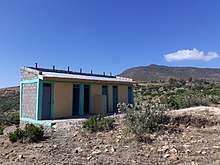
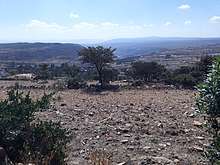
Population
The tabia centre Tukhul has grown to a little town with a few administrative offices, a health post, a primary school, some shops and small restaurants. Thursday is the market day.[7] There are a few more primary schools across the tabia. The original Tukhul village, further uphill (also called “La’ilay Tukhul”) has been largely abandoned, as the inhabitants moved to the road, where they established small businesses while keeping their farmlands. The main other populated places are:[26]
|
|
Religion and churches
Most inhabitants are Orthodox Christians. The following churches are located in the tabia:
- Mesenqoy Mika’el
- Zerfenti Maryam
- Addi Ganfur Arba'ite Insessa
- Rufael
- Sesemat Giyergis
- Miheni Abba Gabir
History
The history of the tabia is strongly confounded with the history of Tembien.
Roads and communication
The main road Mekelle – Hagere Selam – Abiy Addi runs through Tukhul and across the tabia. There are regular bus services to these towns. Further, rural access roads link Mesenqoy and La’ilay Tukhul to Tukhul and the main asphalt road.
Schools
Almost all children of the tabia are schooled,[27] though in some schools there is lack of classrooms, directly related to the large intake in primary schools over the last decades.[28] Schools in the tabia include Zerfenti school, Sesemat school and Afedena school.
Tourism
Its mountainous nature and proximity to Mekelle makes the tabia fit for tourism.[29]
Geotouristic sites
The high variability of geological formations and the rugged topography invite for geological and geographic tourism or "geotourism".[30] Geosites in the tabia include:
- Gypsum quarries
- Limestone quarries
- May Qarano tufa dam (now occupied by the Giba dam building works)
- Miheni exclosure
- Mi’iraf Janhoy (group of 3 olive trees)
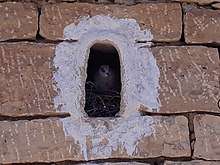
Birdwatching
Birdwatching can be done particularly in exclosures and forests. A dozen bird-watching sites have been inventoried[31] in the tabia and mapped.[32] The bird species are documented on the main Dogu'a Tembien page.

Trekking routes
Trekking routes have been established in this tabia.[33] The tracks are not marked on the ground but can be followed using downloaded .GPX files.[34] As a landmark, the three olive trees (“Mi’iraf Janhoy” at 1940 metres above sea level) along the main road are departure point of:
- Trek 14, to the west of the tabia, and further on, over the ridges, up to Hagere Selam
- Trek 23, to the north of the tabia and further to Ekli Imba the peak of the Medayq massif that dominates the landscape at the north (2799 m)
Inda Siwa, the local beer houses
In the main villages, there are traditional beer houses (Inda Siwa), often in unique settings, which are a good place for resting and chatting with the local people. Most renown in the tabia are[7]
- Abrehet Reda at Tukhul
- Kiros Adane at Tukhul
- Wedase Gebregziabher at Tukhul
Accommodation and facilities
The facilities are very basic.[35] One may be invited to spend the night in a rural homestead or ask permission to pitch a tent. Hotels are available in Hagere Selam and Mekelle.
More detailed information
For more details on environment, agriculture, rural sociology, hydrology, ecology, culture, etc., see the overall page on the Dogu'a Tembien district.
References
- Sembroni, A.; Molin, P.; Dramis, F. (2019). Regional geology of the Dogu'a Tembien massif. In: Geo-trekking in Ethiopia's Tropical Mountains - The Dogu'a Tembien District. SpringerNature. ISBN 978-3-030-04954-6.
- Tefera, M.; Chernet, T.; Haro, W. Geological Map of Ethiopia (1:2,000,000). Addis Ababa, Ethiopia: Ethiopian Institute of Geological Survey.
- Bosellini, A.; Russo, A.; Fantozzi, P.; Assefa, G.; Tadesse, S. (1997). "The Mesozoic succession of the Mekelle Outlier (Tigrai Province, Ethiopia)". Mem. Sci. Geol. 49: 95–116.
- Moeyersons, J. and colleagues (2006). "Age and backfill/overfill stratigraphy of two tufa dams, Tigray Highlands, Ethiopia: Evidence for Late Pleistocene and Holocene wet conditions". Palaeogeography, Palaeoclimatology, Palaeoecology. 230 (1–2): 162–178. doi:10.1016/j.palaeo.2005.07.013.
- Nyssen, Jan; Tielens, Sander; Gebreyohannes, Tesfamichael; Araya, Tigist; Teka, Kassa; Van De Wauw, Johan; Degeyndt, Karen; Descheemaeker, Katrien; Amare, Kassa; Haile, Mitiku; Zenebe, Amanuel; Munro, Neil; Walraevens, Kristine; Gebrehiwot, Kindeya; Poesen, Jean; Frankl, Amaury; Tsegay, Alemtsehay; Deckers, Jozef (2019). "Understanding spatial patterns of soils for sustainable agriculture in northern Ethiopia's tropical mountains". PLOS ONE. 14 (10): e0224041. doi:10.1371/journal.pone.0224041. PMC 6804989. PMID 31639144.
- Jacob, M. and colleagues (2019). Dogu'a Tembien's Tropical Mountain Climate. In: Geo-trekking in Ethiopia's Tropical Mountains - The Dogu'a Tembien District. SpringerNature. doi:10.1007/978-3-030-04955-3_3. ISBN 978-3-030-04954-6.
- What do we hear from the farmers in Dogu'a Tembien? [in Tigrinya]. Hagere Selam, Ethiopia. 2016. p. 100.
- Nigussie Haregeweyn, and colleagues (2006). "Reservoirs in Tigray: characteristics and sediment deposition problems". Land Degradation and Development. 17: 211–230. doi:10.1002/ldr.698.
- Gebremedhin Berhane, and colleagues (2013). "Geological challenges in constructing the proposed Geba dam site, northern Ethiopia". Bulletin of Engineering Geology and the Environment. 72 (3–4): 339–352. doi:10.1007/s10064-013-0480-9. ProQuest 1655734342.
- Gebremedhin Berhane, and colleagues (2013). "Water leakage investigation of micro-dam reservoirs in Mesozoic sedimentary sequences in Northern Ethiopia". Journal of African Earth Sciences. 79: 98–110. doi:10.1016/j.jafrearsci.2012.10.004.
- Nigussie Haregeweyn, and colleagues (2006). "Reservoirs in Tigray: characteristics and sediment deposition problems". Land Degradation and Development. 17: 211–230. doi:10.1002/ldr.698.
- Developers and farmers intertwining interventions: the case of rainwater harvesting and food-for-work in Degua Temben, Tigray, Ethiopia
- Aerts, R; Nyssen, J; Mitiku Haile (2009). "On the difference between "exclosures" and "enclosures" in ecology and the environment". Journal of Arid Environments. 73 (8): 762–763. doi:10.1016/j.jaridenv.2009.01.006.
- Aerts, R.; Lerouge, F.; November, E. (2019). Birds of forests and open woodlands in the highlands of Dogu'a Tembien. In: Geo-trekking in Ethiopia's Tropical Mountains - The Dogu'a Tembien District. SpringerNature. ISBN 978-3-030-04954-6.
- Mastewal Yami, and colleagues (2007). "Impact of Area Enclosures on Density and Diversity of Large Wild Mammals: The Case of May Ba'ati, Douga Tembien Woreda, Central Tigray, Ethiopia". East African Journal of Sciences. 1: 1–14.
- Aerts, R; Lerouge, F; November, E; Lens, L; Hermy, M; Muys, B (2008). "Land rehabilitation and the conservation of birds in a degraded Afromontane landscape in northern Ethiopia". Biodiversity and Conservation. 17: 53–69. doi:10.1007/s10531-007-9230-2.
- Descheemaeker, K. and colleagues (2006). "Sediment deposition and pedogenesis in exclosures in the Tigray Highlands, Ethiopia". Geoderma. 132 (3–4): 291–314. doi:10.1016/j.geoderma.2005.04.027.
- Wolde Mekuria, and colleagues (2011). "Restoration of Ecosystem Carbon Stocks Following Exclosure Establishment in Communal Grazing Lands in Tigray, Ethiopia". Soil Science Society of America Journal. 75 (1): 246–256. doi:10.2136/sssaj2010.0176.
- Bedru Babulo, and colleagues (2006). "Economic valuation methods of forest rehabilitation in exclosures". Journal of the Drylands. 1: 165–170.
- Jacob, M. and colleagues (2019). Exclosures as Primary Option for Reforestation in Dogu'a Tembien. In: Geo-trekking in Ethiopia's Tropical Mountains - The Dogu'a Tembien District. SpringerNature. ISBN 978-3-030-04954-6.
- Reubens, B. and colleagues (2019). Research-based development projects in Dogu'a Tembien. In: Geo-trekking in Ethiopia's Tropical Mountains - The Dogu'a Tembien District. SpringerNature. ISBN 978-3-030-04954-6.
- EthioTrees on Plan Vivo website
- EthioTrees on Davines website
- De Deyn, Jonathan (2019). Benefits of reforestation on Carbon storage and water infiltration in the context of climate mitigation in North Ethiopia. Master thesis, Ghent University, Belgium.
- Naudts, J (2002). Les Hautes Terres de Tembien, Tigré, Ethiopie; Résistance et limites d'une ancienne civilisation agraire; Conséquences sur la dégradation des terres [MSc dissertation]. CNEARC, Montpellier, France.
- Jacob, M. and colleagues (2019). Geo-trekking map of Dogu'a Tembien (1:50,000). In: Geo-trekking in Ethiopia's Tropical Mountains - The Dogu'a Tembien District. SpringerNature. ISBN 978-3-030-04954-6.
- Socio-demographic profile, food insecurity and food-aid based response. In: Geo-trekking in Ethiopia's Tropical Mountains - The Dogu'a Tembien District. SpringerNature. 2019. ISBN 978-3-030-04954-6.
- Hartjen, C.A. and Priyadarsini, S., 2012. Denial of Education. In The Global Victimization of Children (pp. 271-321). Springer, Boston, MA. https://link.springer.com/chapter/10.1007/978-1-4614-2179-5_8 .
- Geo-trekking in Ethiopia's Tropical Mountains - The Dogu'a Tembien District. SpringerNature. 2019. ISBN 978-3-030-04954-6.
- Miruts Hagos and colleagues (2019). Geosites, Geoheritage, Human-Environment Interactions, and Sustainable Geotourism in Dogu'a Tembien. In: Geo-Trekking in Ethiopia's Tropical Mountains, the Dogu'a Tembien District. SpringerNature. doi:10.1007/978-3-030-04955-3_1. ISBN 978-3-030-04954-6.
- Aerts, R.; Lerouge, F.; November, E. (2019). Birds of forests and open woodlands in the highlands of Dogu'a Tembien. In: Geo-trekking in Ethiopia's Tropical Mountains - The Dogu'a Tembien District. SpringerNature. ISBN 978-3-030-04954-6.
- Jacob, M. and colleagues (2019). Geo-trekking map of Dogu'a Tembien (1:50,000). In: Geo-trekking in Ethiopia's Tropical Mountains - The Dogu'a Tembien District. SpringerNature. ISBN 978-3-030-04954-6.
- Nyssen, Jan (2019). Description of Trekking Routes in Dogu'a Tembien. GeoGuide. Springer-Nature. pp. 557–675. doi:10.1007/978-3-030-04955-3_38. ISBN 978-3-030-04954-6.
- https://www.openstreetmap.org/traces/tag/nyssen-jacob-frankl
- Nyssen, Jan (2019). "Logistics for the Trekker in a Rural Mountain District of Northern Ethiopia". Geo-trekking in Ethiopia's Tropical Mountains. GeoGuide. Springer-Nature. pp. 537–556. doi:10.1007/978-3-030-04955-3_37. ISBN 978-3-030-04954-6.